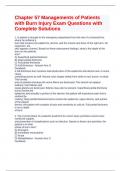Exam (elaborations)
Chapter 57 Managements of Patients with Burn Injury Exam Questions with Complete Solutions
- Course
- Institution
1. A patient is brought to the emergency department from the site of a chemical fire, where he suffered a burn that involves the epidermis, dermis, and the muscle and bone of the right arm. On inspection, the skin appears charred. Based on these assessment findings, what is the depth of the burn ...
[Show more]



